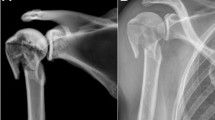Abstract
Objective
To investigate the efficacy of ‘20°-tilt anteroposterior (A-P) radiography’ in the assessment of lateral condylar fractures of the distal humerus.
Materials and methods
Eighteen children with lateral humeral condylar fractures were studied. Every child underwent conventional A-P and lateral radiography, and six children underwent multi-detector computed tomography (MDCT). For the investigation of 20°-tilt radiography, ten children with lateral humeral condylar fractures had conventional and 20°-tilt A-P and lateral radiography both preoperatively and postoperatively. Fragment dislocation was measured at the lateral and medial margins of the fracture on both the conventional A-P and 20°-tilt A-P radiographs.
Results
The lateral condylar fragment was triangular and was most prominent posteriorly. The fracture line was typically tilted approximately 20° to a reference line perpendicular to the long axis of the humerus in the lateral view. The extent of dislocation at the lateral and medial margins of the fracture site by 20°-tilt A-P radiography (9.3 ± 3.6 mm and 5.6 ± 2.5 mm) was significantly wider than that measured by the conventional method (6.8 ± 4.1 mm and 2.0 ± 1.5 mm ), which may influence treatment.
Conclusion
Twenty-degree-tilt A-P radiography may more precisely demonstrate fragment dislocation than standard radiographs and may influence patient treatment.






Similar content being viewed by others
References
Blount WP. The treatment of elbow injuries in children. Trauma 1963; 7: 1–18.
Conner AN, Smith MGH. Displaced fractures of the lateral humeral condyle in children. J Bone Joint Surg Br 1963; 45: 722–726.
Flynn JC, Richards JF. Non-union of minimally displaced fractures of the lateral condyle of the humerus in children. J Bone Joint Surg Am 1971; 53: 1096–1111.
Bast SC, Hoffer MM, Aval S. Nonoperative treatment for minimally and nondisplaced lateral humeral condyle fractures in children. J Pediatr Orthop 1998; 18: 448–450.
Finnbogason T, Karlsson G, Lindberg L, Mortensson W. Nondisplaced and minimally displaced fractures of the lateral humeral condyle in children: a prospective radiographic investigation of fracture stability. J Pediatr Orthop 1995; 15: 422–425.
Flynn JC, Richards JF, Saltzman RI. Prevention and treatment of non-union of slightly displaced fractures of the lateral humeral condyle in children. An end-result study. J Bone Joint Surg Am 1975; 57: 1087–1092.
Mintzer CM, Water PM, Brown DJ, Kasser JR. Percutaneous pinning in the treatment of displaced lateral condyle fractures. J Pediatr Orthop 1994; 14: 462–465.
Kamegaya M, Shinohara Y, Kurokawa M, Ogata S. Assessment of stability in children’s minimally displaced lateral humeral condyle fracture by magnetic resonance imaging. J Pediatr Orthop 1999; 19: 570–572.
Author information
Authors and Affiliations
Corresponding author
Rights and permissions
About this article
Cite this article
Imada, H., Tanaka, R., Itoh, Y. et al. Twenty-degree-tilt radiography for evaluation of lateral humeral condylar fracture in children. Skeletal Radiol 39, 267–272 (2010). https://doi.org/10.1007/s00256-009-0708-8
Received:
Revised:
Accepted:
Published:
Issue Date:
DOI: https://doi.org/10.1007/s00256-009-0708-8




